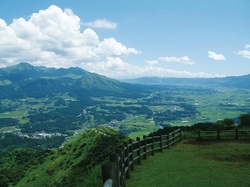
Minamiaso Area
How has the geography and climate allowed Kyushu to flourish agriculturally and how has that affected food cultures in Japan?
1. Propose a methodology for conducting research on your topic. Write a statement of a few sentences on how you plan to gather information and what you think you might do with that information. (Revisit this after you perform the steps below to make sure that they all jive.)
For my method of research I’m thinking of gathering information from several different areas of study and bringing them together in the common goal of "food culture". I hope to establish the influences and events that created the Kyushu we know today. I also hope to find information on specific regions of Kyushu and how those have managed to develop over time. I believe that the geography (for instance the fact that it is a small island, that it has a warmer climate, a variety of land formations including volcanoes etc...) is what has helped to guide the foodways there. I plan to look at a variety of topics; cultural development, identity, history of Japan, history of Kyushu, general ideas of regionalism, geography and lifestyle, trade, religion, current agricultural practices and, media. It seems really broad but I think some wont have much depth (like media, perhaps) but I can use it to support other larger ideas like regionalism and cultural development.
Basically the order I’d like things to go is: Geography-> Kyushu History-> outside influence-> agricultural development-> influence on Japan as a whole -> established foodway of Kyushu/support of “Japanese” identity (and its future).
- Identify terms for library and web searches. Make a list, with the most important terms at the top.
I know those are rather broad, but usually you can see a variety of things and then pick and choose the ones that are truly relevant. It was difficult finding sources on Kyushu specifically which is why I searched just “Kyushu” for any kind of result.
I also just was browsing areas in the library that had to do with Japanese culture...m
3. Identify books and journals/articles that might be useful.
- Daifuku, Hiroshi. “The Early Cultures of the Island of Japan”. Southwest Journal of Anthropology, Vol. 5, No. 3 (Autumn, 1949), pp 253 - 271
- Long, Hoyt. On Uneven Ground. Stanford: Stanford University Press, 2012. Print.
- Japanese Studies. Nosco, Peter. Denver: The Center for Japan Studies at Teikyo Lotetto Heights University, 1997. Print.
- Cobbing, Andrew. Kyushu: Gateway to Japan. Folkstone: Global Oriental LTD, 2009. Print
- Pedlar, Neil. The Imported Pioneers. New York: St. Martin’s Press, Inc., 1990. Print.
- Van der Meer, Cornelis L. J., Yamada, Saburo. Japanese Agriculture: A comparative economic analysis. New York: Routledge, Chapman and Hall. Inc., 1990. Print.
- Shimamura, Takanori. “Cultural Diversity and Folklore Studies in Japan: A Multiculturalist Approach”. Nanzan University, 2003. October 4, 2012.
- The Future of the Countryside. Dir. Andy Walker. BBC Education, 1994. Film.
- Yamaguchi, Hirofumi & Okamoto, Masafumi. “Traditional seed production in landacres of daikon (Raphanus sativus) in Kyushu, Japan”. Euphytica, Kluwer Academic Publishers, May, 1997. 4 Oct, 2012.
 RSS Feed
RSS Feed